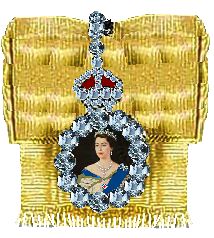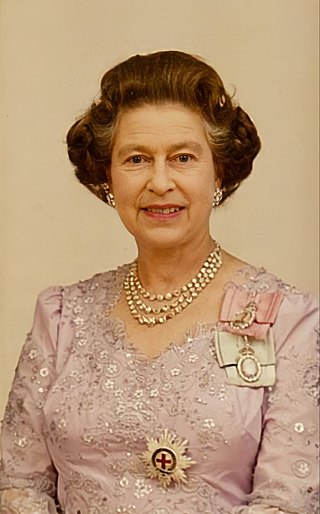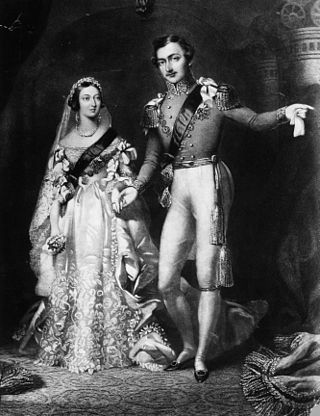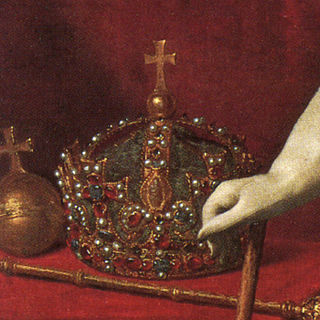
The Most Noble Order of the Garter is an order of chivalry founded by Edward III of England in 1348. The most senior order of knighthood in the British honours system, it is outranked in precedence only by the decorations of the Victoria Cross and the George Cross. The Order of the Garter is dedicated to the image and arms of Saint George, England's patron saint.

The Royal Victorian Order is a dynastic order of knighthood established in 1896 by Queen Victoria. It recognises distinguished personal service to the monarch, members of the royal family, or to any viceroy or senior representative of the monarch. The present monarch, King Charles III, is the sovereign of the order. The order's motto is Victoria. The order's official day is 20 June. The order's chapel is the Savoy Chapel in London.

The Most Exalted Order of the Star of India is an order of chivalry founded by Queen Victoria in 1861. The Order includes members of three classes:
- Knight Grand Commander (GCSI)
- Knight Commander (KCSI)
- Companion (CSI)

The Order of the Dannebrog is a Danish order of chivalry instituted in 1671 by Christian V. Until 1808, membership in the Order was limited to fifty members of noble or royal rank, who formed a single class known as White Knights to distinguish them from the Blue Knights who were members of the Order of the Elephant. In 1808, the Order was reformed and divided into four classes. The statute of the Order was amended in 1951 by a Royal Ordinance so that both men and women could be members of the Order. Today, the Order of the Dannebrog is a means of honouring and rewarding the faithful servants of the modern Danish state for meritorious civil or military service, for a particular contribution to the arts, sciences or business life, or for working for Danish interests.

The Royal Victorian Chain is a decoration instituted in 1902 by King Edward VII as a personal award of the monarch. It ranks above the Royal Victorian Order, with which it is often associated but not officially related. Originally reserved for members of the royal family, the chain is a distinct award conferred only upon the highest dignitaries, including foreign monarchs, heads of state, and high-ranking individuals such as the Archbishop of Canterbury.
A royal family order or royal family decoration is a decoration conferred by the head of a royal family to their female relations. Such a decoration is considered more of a personal memento than a state decoration, although it may be worn during official state occasions.

A livery collar or chain of office is a collar or heavy chain, usually of gold, worn as insignia of office or a mark of fealty or other association in Europe from the Middle Ages onwards.

Canadian royal symbols are the visual and auditory identifiers of the Canadian monarchy, including the viceroys, in the country's federal and provincial jurisdictions. These may specifically distinguish organizations that derive their authority from the Crown, establishments with royal associations, or merely be ways of expressing loyal or patriotic sentiment.

In modern heraldry, a royal cypher is a monogram or monogram-like device of a country's reigning sovereign, typically consisting of the initials of the monarch's name and title, sometimes interwoven and often surmounted by a crown. Such a cypher as used by an emperor or empress is called an imperial cypher. In the system used by various Commonwealth realms, the title is abbreviated as 'R' for 'rex' or 'regina'. Previously, 'I' stood for 'imperator' or 'imperatrix' of the Indian Empire.

The Royal Family Order of Elizabeth II is an honour which was bestowed on female members of the British royal family by Queen Elizabeth II. The order is worn by recipients on formal occasions.

The Royal Family Order of George V is an honour that was bestowed on female members of the British royal family by King George V.

The Royal Family Order of George VI is an honour that was bestowed on female members of the British royal family by King George VI.

The Order of Military Merit is a military honour for merit that is, within the Canadian system of honours, the second highest order administered by the Governor in Council on behalf of the Canadian monarch.

The Royal Family Order of George IV is an honour that was bestowed as a mark of personal esteem on female members of the British royal family by King George IV. It was the first Royal Family Order issued in the United Kingdom. Prior to George IV's accession in 1820, both ladies and gentlemen of the Court, as well as female members of the royal family, had worn the Sovereign's portrait set in a jewelled frame. George IV formalised the order.

Elizabeth II owned a historic collection of jewels – some as monarch and others as a private individual. They are separate from the gems and jewels of the Royal Collection, and from the coronation and state regalia that make up the Crown Jewels.

Queen Victoria of the United Kingdom married Prince Albert of Saxe-Coburg and Gotha on 10 February 1840. She chose to wear a white wedding dress made from heavy silk satin, making her one of the first women to wear white for their wedding. The Honiton lace used for her wedding dress proved an important boost to Devon lace-making. Queen Victoria has been credited with starting the tradition of white weddings and white bridal gowns, although she was not the first royal to be married in white.

The Colonial Auxiliary Forces Officers' Decoration, post-nominal letters VD, was established in 1899 as recognition for long and meritorious service as a part-time commissioned officer in any of the organized military forces of the British Colonies, Dependencies and Protectorates. It superseded the Volunteer Officers' Decoration for India and the Colonies in all these territories, but not in the Indian Empire.

The Most Illustrious Order of Queen Sālote Tupou III is a knighthood order of the Kingdom of Tonga.

The Tudor Crown was a state crown created in the early 16th century for either Henry VII or Henry VIII, the first Tudor monarchs of England, and destroyed in 1649 during the English Civil War. It was described by the art historian Sir Roy Strong as 'a masterpiece of early Tudor jeweller's art'.

The Royal Family Order of Charles III is an honour that is bestowed on female members of the British royal family by King Charles III. The order is worn by recipients on formal occasions.
























